Spirulidae
Spirula spirula
Ram's-horn squid
Introduction
Spirula spirula is a small, muscular species (45 mm ML) found in mesopelagic waters of the tropical open ocean. In the title photographs, the skin of the mantle is missing. The intact mantle is covered with regularly aligned collagen fibers that produce a silvery sheen, as seen on the head in the title photographs (Herring et al., 1981). Spirula carries an unusual internal shell that is calcareous and has the shape of a horn coiled in a single plane without the coils touching one another (open planispiral).

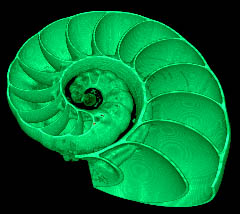
Figure. Left - Side view of the shell of Spirula. Photograph by R. Young of a shell found on a Florida beach. Right - Cut-away view of the shell provided by ray tomography showing the phragmocone with septa and siphuncle. Photograph taken by the atomic and nuclear physics group from the University of Fribourg in Switzerland, and provided by Hans Ueli Johner.
The shell, which retains the phragmocone and siphuncle of its distant ancestors, is used as a buoyancy device. The posterior position of the shell within the body causes the animal to generally orient vertically with the head downward. The unusual general appearance of Spirula with a narrow arm crown, bulging eyes, the peculiar structure of the mantle, the transverse orientation of the fins and the presence of the coiled shell makes this species very different in appearance from all other cephalopods.
The large posterior guard-like sheath of fossil relatives of Spirula seems to be designed to function as a counterweight to maintain the animal in a horizontal position. Such an orientation is particularly important for a bottom-associated animal that swims just above the ocean floor (Naef 1921-23). Presumably the ancestors of Spirula were bottom associated and some remnants of this behavior apparently remains in their life history and distribution (Young, et al., 1998). A small remnant of the sheath exists on the Spirula shell and a remnant of the ancestral habitat remains in Spirula's apparent benthic spawning (Young, et al., 1999).
Brief diagnosis:
A decapodiform ...
- with a calcareous shell that is a phragmocone and has the shape of a coiled horn.
Characteristics
- Arms
- Arms with suckers in four series.
- Both arms IV hectocotylized.
- Tentacles (More details of the tentacular clubs can be seen here.)
- Tentacular clubs without proximal locking apparatus.
- Tentacular clubs with suckers in 8-16 irregular series depending on state of contraction (Naef, 1921-23); not divided into manus and dactylus.
- Club suckers without circularis muscles.
- Head
- Head with tentacle pockets.
- Eyes without corneas.
- Buccal membrane with 7 trabeculae which lack suckers.
- Beaks: Descriptions can be found here: Lower beak; upper beak.
- Funnel
- Funnel without lateral adductor muscles.
- Funnel without lateral adductor muscles.
- Mantle
- Mantle locking-apparatus does not reach anterior mantle margin.
- Mantle locking-apparatus does not reach anterior mantle margin.
- Fins
- Fins separate, terminal and lie in a plane nearly transverse to body axis.
- Fins with posterior lobes.
- Photophores
- Large photophore at posterior end of body.
- Large photophore at posterior end of body.
- Shell
- Calcareous shell a phragmocone, curved ventrally in open planispiral; round in cross section and possessing a ventral siphuncle and transverse septa.
- Calcareous shell a phragmocone, curved ventrally in open planispiral; round in cross section and possessing a ventral siphuncle and transverse septa.
- Viscera
- Gills without brachial canal.
- Right oviduct absent.
- Females with accessory nidamental glands.
- Radula absent.
- Ink sac reduced.
- Anal flaps absent.
- Digestive gland paired; esophagus passes between members of the pair.
Nomenclature
A list of all nominal genera and species in the Spirulidae can be found here. The list includes the current status and type species of all genera, and the current status, type repository and type locality of all species and all pertinent references.
Behavior
Spirula is able to withdraw its head and arms completely within the mantle; the mantle opening can then be closed by folding over the large dorsal and ventrolateral extensions (= flaps) of the mantle margin (Bruun, 1943). The photophore at the posterior end of the body is known to glow for hours at a time (Schmidt, 1922). When swimming slowly downward, head first, the terminal fins are pointed upward (i.e. posteriorly) and move with a rapid "waving or fluttering motion" that propels the animal downward (Bruun, 1943).
Virtually all cephalopods have mobile irises but for an oceanic, pelagic decapodiform the extreme contraction seen below in Spirula is unusual.


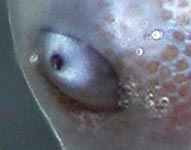
Figure. Views of the iris of Spirula spirula, 23 mm ML, western North Atlantic. Left - Dorsal view. Right - Dorsal-oblique view. Note the wide-open eyelid and the strongly contracted iris leaving a tiny pupil. Photogaphs by M. Vecchione.
Life History
Mature ovarian eggs are 1.7 mm in the longest diameter (Bruun, 1943). Bruun (1943) suggests that the eggs are laid on the ocean floor and the capture of very small animals in deep water supports this idea (Bruun, 1943; Clarke, 1970). Bruun (1943) illustrated two small Spirula (see below), one that had a shell with just two and one half chambers. The smaller one (2.8 mm ML) is close to being a hatchling. The eyes in these individual are small and the buccal mass is very large with the beaks extending beyond the short arms. Note that only three arm pairs are present.

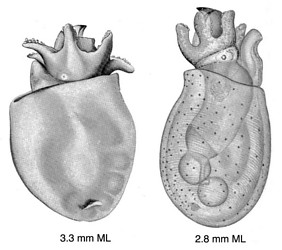
Figure. Views of paralarvae of Spirula spirula. Left - Ventral view. Drawing from Clarke (1970). Right - Drawing from Bruun (1943).
The shift in size frequency distribution over time in the region of the Canary Islands suggests to Clarke (1970) that this cephalopod has a life-span of 18-20 months. The ventral arms of the male are hectocotylized: They are much longer and thicker than the other arms (see title photograph) and possess a variety of unusual flaps and papillae but lack suckers.
Distribution
Vertical distribution
Clarke (1969) found that Spirula occurs at depths between 550 and 1000 m during the day (peak distribution is at 600-700 m) and at night migrates into the upper 100-300 m (peak at 200-300 m).


Figure. Graph of 70 Spirula spirula captured with opening/closing nets near the Canary Islands, eastern North Atlantic (Clarke, 1969). Yellow circles- Day captures. Blue triangles- Night captures. Oversized symbols represent two captures.
Geographical distribution
Most captures come from the tropical Atlantic and tropical IndoWest Pacific Oceans. Bruun (1943) found that Spirula is distributed mostly over the slopes of continents or islands where the bottom depth is between 1000 and 2000 m. The most numerous captures came from the vicinity of oceanic islands. Indeed, this animal was the most abundant midwater cephalopod collected in the region of the Canary Islands by Clark (1969).
References
Bruun, A. F. 1943. The biology of Spirula spirula (L.). Dana-Report No. 24. 49pp.
Chun, C. 1910. Die Cephalopoden. Oegopsida. Wissenschaftliche Ergebnisse der Deutschen Tiefsee Expedition auf dem Dampfer "Valdivia" 1898-1899, 18(1):1-401.
Clarke, M. R. 1969. Cephalopoda collected on the SOND cruise. J.Mar. Biol. Ass. U.K., 49: 961-976.
Clarke, M. R. 1970. Growth and development of Spirula spirula. Jour. Mar. Biol. Ass. U. K. 50: 53-64.
Herring, P. J., M. R. Clarke, S. von Boletzky and K. P. Ryan. 1981. The light organs of Sepiola atlantica and Spirula spirula (Mollusca: Cephalpooda): bacterial and intrinsic systems in the order Sepioidea. J. Mar. Biol. Ass. U.K., 61: 901-916.
Naef, A. 1922 -- Die Fossilen Tintenfische. Gustav Fischer, Jena. 322 pp.
Schmidt, J. 1922. Live specimens of Spirula. Nature, 110, No. 2271.
Young, R. E., M. Vecchione and D. Donovan. 1998. The evolution of coleoid cephalopods and their present biodiversity and ecology. South African Jour. Mar. Sci., 20: 393-420.
Title Illustrations

| Scientific Name | Spirulida |
|---|---|
| Sex | Male |
| View | lateral |
| Copyright |
© 1998 Martina A. Compagno Roeleveld (ca. 1946-2006)

|
| Location | western North Atlantic |
|---|---|
| View | Side |
| Size | 23 mm ML |
| Image Use |
 This media file is licensed under the Creative Commons Attribution-NonCommercial License - Version 3.0. This media file is licensed under the Creative Commons Attribution-NonCommercial License - Version 3.0.
|
| Copyright |
© 2004

|
About This Page
Page copyright © 2019
 Page: Tree of Life
Spirulidae . Spirula spirula . Ram's-horn squid.
The TEXT of this page is licensed under the
Creative Commons Attribution-NonCommercial License - Version 3.0. Note that images and other media
featured on this page are each governed by their own license, and they may or may not be available
for reuse. Click on an image or a media link to access the media data window, which provides the
relevant licensing information. For the general terms and conditions of ToL material reuse and
redistribution, please see the Tree of Life Copyright
Policies.
Page: Tree of Life
Spirulidae . Spirula spirula . Ram's-horn squid.
The TEXT of this page is licensed under the
Creative Commons Attribution-NonCommercial License - Version 3.0. Note that images and other media
featured on this page are each governed by their own license, and they may or may not be available
for reuse. Click on an image or a media link to access the media data window, which provides the
relevant licensing information. For the general terms and conditions of ToL material reuse and
redistribution, please see the Tree of Life Copyright
Policies.
- First online 04 July 2012
- Content changed 26 March 2019
Citing this page:
Tree of Life Web Project. 2019. Spirulidae . Spirula spirula . Ram's-horn squid. Version 26 March 2019 (under construction). http://tolweb.org/Spirula_spirula/148171/2019.03.26 in The Tree of Life Web Project, http://tolweb.org/





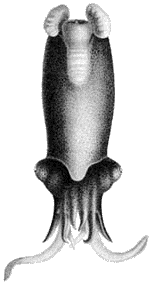

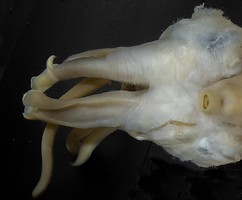






 Go to quick links
Go to quick search
Go to navigation for this section of the ToL site
Go to detailed links for the ToL site
Go to quick links
Go to quick search
Go to navigation for this section of the ToL site
Go to detailed links for the ToL site